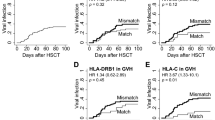Abstract
A 36-year-old Caucasian male presented with adult T-cell leukemia/lymphoma (ATL). HTLV-1 contamination was attributed to a neonatal exchange transfusion. Remission was achieved but 11 years later he presented with symptoms suggesting ATL relapse. Molecular studies of T-cell clonality and virus integration sites revealed a clonal disease, distinct from the first tumor.


Similar content being viewed by others
References
Gessain A, Cassar O. Epidemiological aspects and World distribution of HTLV-1 infection. Front Microbiol. 2012;3(388):1–23.
Philip T, Meckenstock R, Deconnick E, Carrie C, Bailly C, Colombat P, et al. Treatment of poor prognosis Burkitt’s lymphoma in adults with the Societe Francaise d’Oncologie Pediatrique LMB Protocol—a study of the Federation Nationale des Centres de Lutte Contre le Cancer (FNLCC). Eur J Cancer Oxf Engl 1990. 1992;28A(12):1954–9.
Hogan CA, Iles J, Frost EH, Giroux G, Cassar O, Gessain A, et al. Epidemic history and iatrogenic transmission of blood-borne viruses in mid-20th century Kinshasa. J Infect Dis. 2016;214(3):353–60.
Desrames A, Cassar O, Gout O, Hermine O, Taylor GP, Afonso PV, et al. Northern African strains of human T-lymphotropic virus type 1 arose from a recombination event. J Virol. 2014;88(17):9782–8.
Sibon D, Cassar O, Duga I, Brouzes C, Ghez D, Pasquier C, et al. Adult T-cell leukemia/lymphoma in a caucasian patient after sexual transmission of Human T-Cell lymphotropic virus type 1. Open Forum Infect Dis. 2015;2(22):1–5.
Katamine S, Moriuchi R, Yamamoto T, Terada K, Eguchi K, Tsuji Y, et al. HTLV-I proviral DNA in umbilical cord blood of babies born to carrier mothers. Lancet. 1994;343(8909):1326–7.
Percher F, Jeannin P, Martin-Latil S, Gessain A, Afonso PV, Vidy-Roche A, et al. Mother-to-child transmission of HTLV-1 epidemiological aspects, mechanisms and determinants of mother-to-child transmission. Viruses. 2016;8(2):40.
Hino S. Establishment of the milk-borne transmission as a key factor for the peculiar endemicity of human T-lymphotropic virus type 1 (HTLV-1): the ATL Prevention Program Nagasaki. Proc Jpn Acad Ser B Phys Biol Sci. 2011;87(4):152–66.
Murphy EL, Hanchard B, Figueroa JP, Gibbs WN, Lofters WS, Campbell M, et al. Modelling the risk of adult T-cell leukemia/lymphoma in persons infected with human T-lymphotropic virus type I. Int J Cancer. 1989;43(2):250–3.
Bartholomew C, Jack N, Edwards J, Charles W, Corbin D, Cleghorn FR, et al. HTLV-I serostatus of mothers of patients with adult T-cell leukemia and HTLV-I-associated myelopathy/tropical spastic paraparesis. J Hum Virol. 1998;1(4):302–5.
Iwanaga M, Watanabe T, Yamaguchi K. Adult T-cell leukemia: a review of epidemiological evidence. Front Microbiol. 2012;3(322):1–13.
Utsunomiya A, Choi I, Chihara D, Seto M. Recent advances in the treatment of adult T-cell leukemia–lymphomas. Cancer Sci. 2015;106(4):344–51.
van Dongen JJM, Langerak AW, Bruggemann M, Evans PAS, Hummel M, Lavender FL, et al. Design and standardization of PCR primers and protocols for detection of clonal immunoglobulin and T-cell receptor gene recombinations in suspect lymphoproliferations: report of the BIOMED-2 Concerted Action BMH4-CT98-3936. Leukemia. 2003;17(12):2257–317.
Gillet NA, Malani N, Melamed A, Gormley N, Carter R, Bentley D, et al. The host genomic environment of the provirus determines the abundance of HTLV-1-infected T-cell clones. Blood. 2011;117(11):3113–22.
Manivannan K, Rowan AG, Tanaka Y, Taylor GP, Bangham CRM. CADM1/TSLC1 identifies HTLV-1-infected cells and determines their susceptibility to CTL-mediated lysis. PLoS Pathog. 2016;12(4):e1005560.
Author information
Authors and Affiliations
Corresponding author
Ethics declarations
Conflict of interest
The authors declare they have no conflict of interest.
Funding
This work was supported by the French Government’s Investissement d’Avenir program, Laboratoire d’Excellence “Integrative Biology of Emerging Infectious Diseases” (Grant No. ANR-10-LABX-62-IBEID) and by a Wellcome Trust Senior Investigator Award.
About this article
Cite this article
Oksenhendler, E., Turpin, J., Lhote, R. et al. Persistent risk of adult T-cell leukemia/lymphoma after neonatal HTLV-1 infection through exchange transfusion. Int J Hematol 105, 859–862 (2017). https://doi.org/10.1007/s12185-016-2174-0
Received:
Revised:
Accepted:
Published:
Issue Date:
DOI: https://doi.org/10.1007/s12185-016-2174-0




